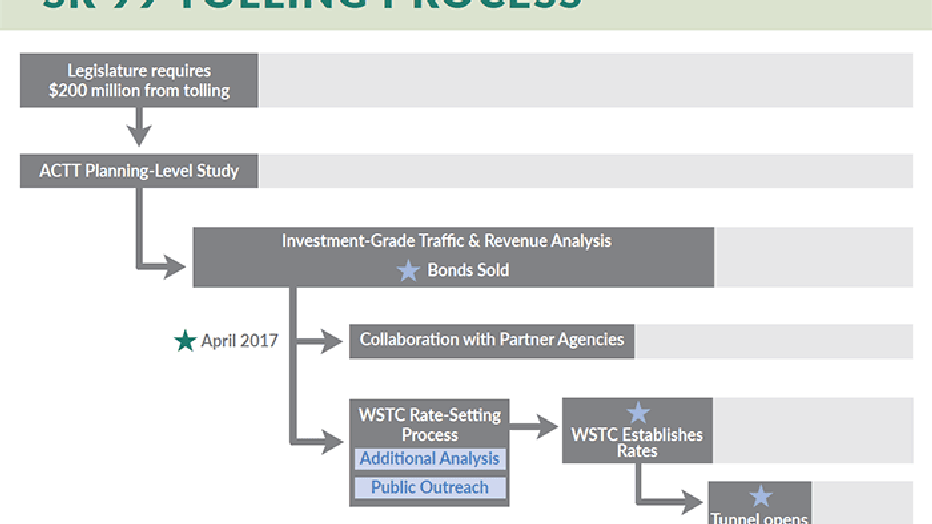SR 99 tunnel slated for fall opening: What to know about tolling, viaduct closure & more
SEATTLE -- Bertha finished boring the path for a new tunnel under Seattle nearly one year ago.
Since then, construction crews have finished installing a double-deck highway end-to-end inside the tunnel. That leaves crews to finish installing and testing the $3.2 billion tunnel's advanced operational and safety systems.
So when will the tunnel open? How much will tolls cost? And what happens to the Alaskan Way Viaduct?
When will the tunnel open and what happens to the viaduct?
After the tunnel is finished, crews will close the Alaskan Way Viaduct for several weeks to realign the highway to the tunnel. The viaduct will be permanently closed, and it will take a few weeks before the tunnel will open to traffic.
Demolition of the viaduct will begin some time after the tunnel opens to traffic.
That paves the way for the Seattle Department of Transportation to build a new Alaskan Way along the downtown waterfront.
How much will tolls cost?
"Funding for the $3.2 billion viaduct replacement program comes from state, federal and local sources as well as the Port of Seattle and tolls on drivers using the tunnel. Of that total cost, the 2012 Legislature stated $200 million must come from toll funding," WSDOT says.
The Washington State Transportation Commission is responsible for setting toll rates: "The WSTC will consider multiple factors in order to determine the best rate to minimize traffic diversion onto other roads but still generate necessary revenue for the tunnel. They will use the results from the investment-grade study as a baseline for their work."
A study came up with two main possibilities: tolls ranging from $1 to $2.50 at peak times -- which would raise the $200 million as required by state law -- and a second option kept trips closer to $1 to $1.25 at peak times.
A final decision has not yet been made.

WSDOT
One of 'smartest' tunnels ever built
The safety systems will make the SR 99 tunnel one of the smartest tunnels ever built, including:
What about the delays?
The project is about two years behind schedule after Bertha's main bearing was damaged in December of 2013 -- only about 10 percent of the tunnel had been bored.
Seattle Tunnel Partners and Bertha's manufacturer Hitachi Zosen came up with a plan to lift four million pounds of machinery up through a hole in the ground to repair the cutter head.
Two years later, STP resumed tunneling and completed boring the tunnel. WSDOT says the cause of the damage is under dispute and in litigation.

WSDOT
USEFUL LINKS:
Why build a tunnel?
Transportation officials explain the decision to replace the viaduct with a tunnel:
State Route 99 is critically important to local and regional transportation as it is one of only two major north-south highways through Seattle. The portion of SR 99 that travels through downtown Seattle is an elevated double-deck road called the Alaskan Way Viaduct. It was built in the 1950’s and is vulnerable to earthquakes, which is why replacing the viaduct is critical to public safety.
After the 2001 Nisqually earthquake damaged the viaduct, the Washington State Department of Transportation (WSDOT) reinforced the road, imposed roadway restrictions for large vehicles and began frequent monitoring and quarterly inspections to make sure the road remains safe for everyday use.
In 2009, after an extensive public process, the Washington State Legislature voted to replace the viaduct with a bored tunnel. This construction method allowed SR 99 to remain open through Seattle during construction. In 2011, crews demolished the southern mile of the viaduct – nearly half the structure – and replaced it with a new road. After the new SR 99 tunnel opens, the Alaskan Way Viaduct will be demolished to clear the way for Seattle’s Department of Transportation to build a new Alaskan Way on Seattle’s waterfront.
WSDOT hired Seattle Tunnel Partners as the design-build contractor of the SR 99 tunnel. Tunneling started in July 2013 with the world’s largest tunneling machine - a 57.5-foot-diameter machine named Bertha, after Seattle’s first female mayor Bertha Knight Landes.

